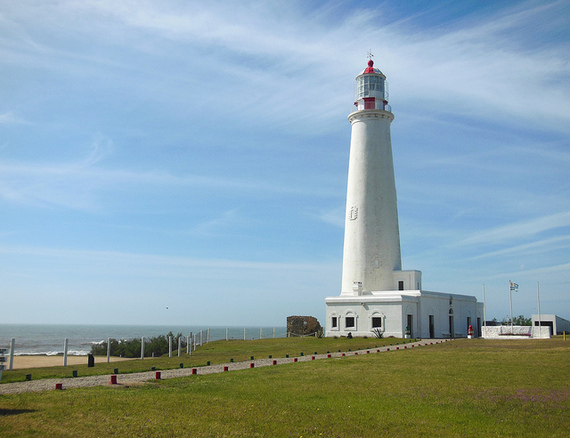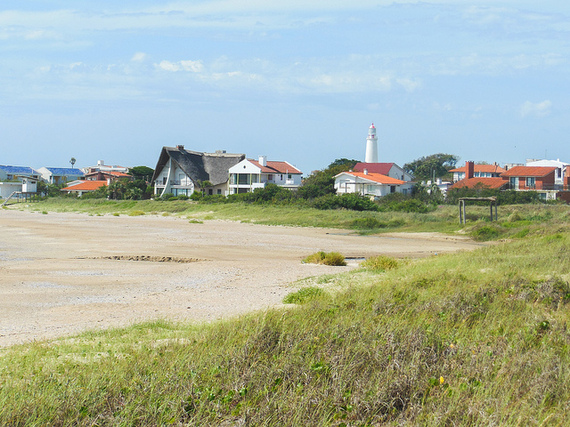This article comes to us courtesy of InternationalLiving.com, the world's leading authority on how to live, work, invest, travel, and retire better overseas.
What if you could go back in time to a white-sand beach on the Atlantic coast before heavy development came and prices went through the roof? A time when a beach home was a cottage instead of a high-rise condo, and owning it was a lifestyle choice, not a status symbol...
If your idea of paradise is a tranquil beach where a couple can live comfortably for
$1,200, including renting a furnished home, then Uruguay's Department of Rocha is a place you should definitely know about.

Courtesy of David Hammond, InternationalLiving.com
A "department" in Uruguay is like a state or province. Rocha covers 4,074 square miles and stretches 112 miles along the Atlantic coast between Punta del Este, the largest beach resort in Uruguay, and the Brazilian border. It is the most rural coastal region of Uruguay, with a full-time population of just 68,100.
Much of Rocha is grazing country, a land of cattle and sheep pastures dotted with the occasional palm tree and granite outcrop. Three large lagoons attract millions of wildfowl annually. But the most popular natural attraction in Rocha is the coastline: long, white-sand beaches and blue Atlantic waters punctuated with capes and rocky points.
This is what attracts hundreds of thousands of tourists each year. That--along with agriculture--is the region's biggest earner. And the economy is about to expand. Construction of a new regional harbor, a barge-and-rail network into Brazil, and a new paper mill are in the works.
Like other coastal towns in Uruguay, Rocha's beach towns have small year-round populations that explode with vacationers during the southern hemisphere's summer months of January and February. In January the population of Rocha's beach towns grows by 800 percent to 2,000 percent.
That means living full-time in a Rocha beach town has an annual rhythm--bustling during the summer and quiet during the winter. For some folks, summer is a time for play and meeting new people, while others earn money from seasonal tourist businesses. In the off-season, full-time residents return to personal interests. They enjoy the outdoors without the summer crowds and visit with neighbors.
Each beach town has its own character and presents unique opportunities. And I recently spent time finding out more about La Paloma and La Pedrera and what they had to offer...
La Paloma--Largest and Most-Developed Rocha Beach Town
La Paloma is just 70 miles east of the glitz and glamour of Punta del Este, South America's most popular resort town. La Paloma's fulltime population of 3,500 skyrockets in summer (mid-December through February), as vacationers arrive in droves to enjoy a simpler and more laidback experience.
"The coastline has different kinds of beaches and wildlife. We walk on the beach at least once a week, if not more," says Kristen Harden, who moved from Michigan to La Paloma with her husband Nate five years ago.

Courtesy of David Hammond, InternationalLiving.com
While a few more expats live in town, the majority live outside the city limits on small homesteads and gentleman farms of two to 25 acres. Nate and Kristen do both. They rent a home in town during the winter, enjoying the convenience of being there when the weather is cool and rental prices are low. Then, in the summer, when vacation properties' rental prices go up and the weather is warm, they live on their homestead outside town.
Fewer owners rent out their properties long-term, but some do. A two-bedroom, one-bathroom home may rent for $600 a month on an annual lease. Lower monthly rates are available for renting just during the low season, as Nate and Kristen do. Most rentals in La Paloma are short-term vacation rentals. A well-located, two-bedroom, one-bathroom home in good condition can bring in $120 a night during the high season.
For both vacationing and full-time living, La Paloma is a lower-cost alternative to Punta del Este. Real estate prices and property taxes are lower, and supermarket items cost less.
In general, a couple can live on $1,200 a month in La Paloma, including rent. Those who own their own home can live comfortably on $800 a month. Some people garden and keep chickens, which pushes costs even lower. "Overall, it is very reasonable to live here. We have a local wine producer that sells palatable wine for $2.80 a liter. Got to love the local stuff. It's the same for honey. Uruguay is great for small-production agricultural goods," says Nate.

Courtesy of David Hammond, InternationalLiving.com
"We find everything we need in La Paloma. Of course, we like to cook, and there are times when we can't get certain ingredients that we want, such as sriracha chili sauce. But as far as needs go, we have more than we need to live comfortably here," says Kristen.
Nate and Kristen have a mix of both expat and Uruguayan friends. "Despite the population drop in the winter, there is a great community of people here. The locals are friendly and welcoming. We have had more than our fair share of help from them over the years," says Kristen.
La Pedrera--Small and Boutique
A 15-minute drive east from La Paloma, on the paved and well-maintained Ruta 10, takes you to La Pedrera. It's a small town of around 225 permanent residents. But it's more than just a satellite of La Paloma. It has a distinctive setting and charm that has caught on with affluent vacationers.
On my first visit to La Pedrera, I was impressed by the picturesque waterfront bluff overlooking the Atlantic. It's a real landmark, a beautiful, natural place with a bohemian vibe. And in the summer here, you can find interesting cuisine, comfortable accommodation, and sophisticated people to meet.
The bluff is about five blocks wide and descends gradually to sandy beaches on both sides. At the top of the bluff you'll find parking and a grassy area, with public benches and a low rail fence guarding the steep drop to the rocks and sea below.
East of the bluff is the white-sand Playa de Desplayado, the most popular beach in La Pedrera for sunbathers and swimmers alike.

Courtesy of David Hammond, InternationalLiving.com
West of the bluff is Playa del Barco (Boat Beach), one of the best surf spots on Uruguay's coast. The beach gets its name from the 1971 wreck of a Taiwanese fishing boat, Cathay 8, whose rusty hull is still visible. From the beach the land gently rises, so many properties even several blocks back from the beach have water views.
Most businesses in La Pedrera revolve around the summer high season. The summer action is centered along the Avenida Principal, which runs three-quarters of a mile through town from Ruta 10 to the bluff.
La Pedrera doesn't have the level of services that La Paloma does. Residents of La Pedrera make the short trip to La Paloma when they need a bank, a doctor, or to fill up with gas. Just a few businesses here stay open during the off season.
La Pedrera usually has good food options in the summer, though the restaurant scene changes from year to year, due to turnover in owners and chefs.
You don't need a car in La Pedrera. Four buses a day go to La Paloma and back and another four buses run to Montevideo, just under four hours away.
The town's real estate prices reflect its popularity with affluent vacationers. But look farther back from the beach and you'll find prices that range from $90,000 to $150,000 for a comfortable home. Year-round rentals, while not common, are available. A simple two-bedroom home, five blocks or more from the beach, may rent for $400 a month on a year lease. The largest selection of properties for sale and for rent are listed with Punto Río.
Related Articles:
Video: Where To Buy Real Estate In Uruguay-Three Areas To Consider
Retirement In Uruguay Is Unique
A New Income In Uruguay Transformed This Single Mom's Life
Earlier on Huff/Post50:



